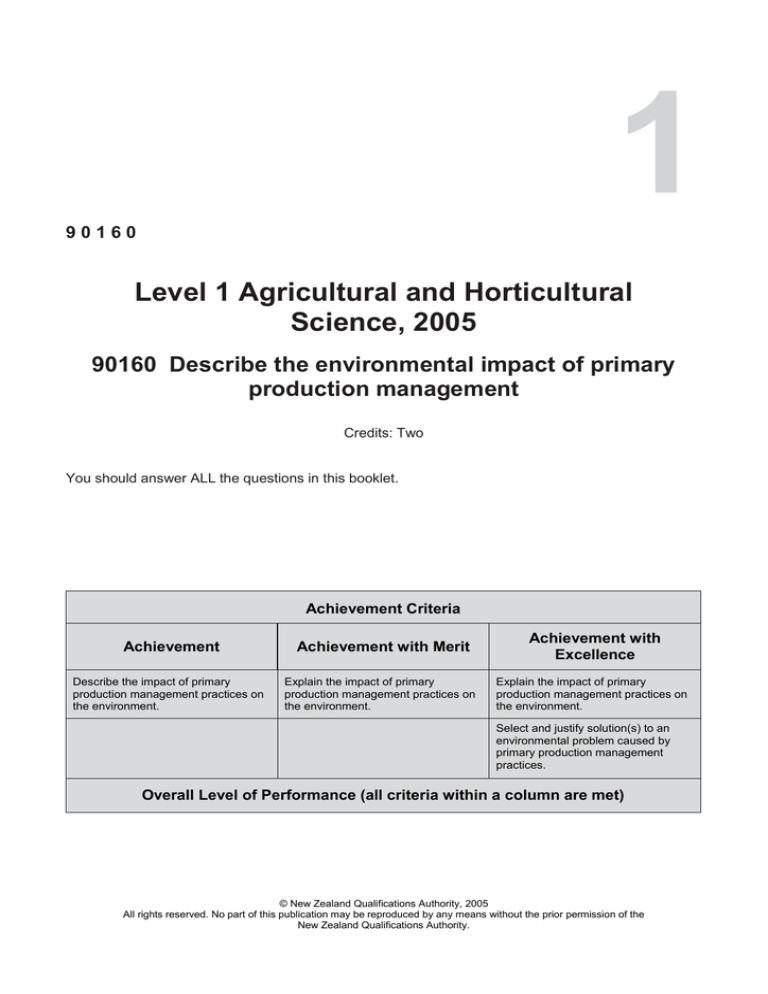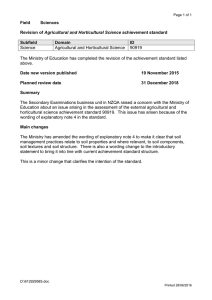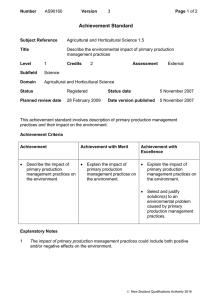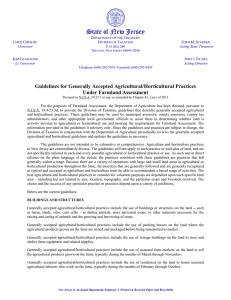
1
90160
Level 1 Agricultural and Horticultural
Science, 2005
90160 Describe the environmental impact of primary
production management
Credits: Two
You should answer ALL the questions in this booklet.
Achievement Criteria
Achievement
Achievement with Merit
Achievement with
Excellence
Describe the impact of primary
production management practices on
the environment.
Explain the impact of primary
production management practices on
the environment.
Explain the impact of primary
production management practices on
the environment.
Select and justify solution(s) to an
environmental problem caused by
primary production management
practices.
Overall Level of Performance (all criteria within a column are met)
© New Zealand Qualifications Authority, 2005
All rights reserved. No part of this publication may be reproduced by any means without the prior permission of the
New Zealand Qualifications Authority.
You are advised to spend 25 minutes answering the questions in this booklet.
The photographs below show some management practices that have positive or negative
effects on the environment.
[For copyright reasons, these resources cannot be reproduced here. See below.]
A: Spraying effluent from a dairy farm
B: A helicopter protecting grapes against frost
C: Direct drilling a new crop
D: Burning rubbish on a farm
E: Spraying weeds
F: Biological control of pests
Sources:
A Environment Waikato Regional Council, Water Factsheet 10
B Dominion Post newspaper
C Landwise website, www.landwise.org.nz
D Hawkes Bay Regional Council Farmers’ Guide
E Hawkes Bay Regional Council Farmers’ Guide
F http://www.bonideproducts.com/products/bt.htm
L1 Agricultural and Horticultural Science 2005, 90160 – page 2 of 7
QUESTION ONE
(a)
Select TWO of the management practices shown on page 2 that may have a positive impact on
the environment. Describe the impact and explain why it is positive.
(i)
Positive management practice (1):
(write the letter)
Description:
Explanation:
(ii)
Positive management practice (2):
(write the letter)
Description:
Explanation:
L1 Agricultural and Horticultural Science 2005, 90160 – page 3 of 7
(b)
Select TWO of the management practices shown on page 2 that may have a negative impact
on the environment. Describe the impact and explain why it is negative.
(i)
Negative management practice (1):
(write the letter)
Description:
Explanation:
(ii)
Negative management practice (2):
(write the letter)
Description:
Explanation:
L1 Agricultural and Horticultural Science 2005, 90160 – page 4 of 7
QUESTION TWO
The Dirty Dirt Saga
[For copyright reasons, this resource cannot be reproduced here. See below.]
Source: (adapted) The New Zealand Herald, 27 November 2004.
Some negative management practices that have been used in the past have resulted in the impacts
described in the above article. Horticulturists used these chemicals to manage pests and diseases.
(a)
State ONE positive management practice that is now used to control pests and diseases on
crops, and explain how it prevents chemicals from building up in the soil and causing pollution.
Management practice:
Explanation of how this practice impacts positively on the environment:
L1 Agricultural and Horticultural Science 2005, 90160 – page 5 of 7
“Babies at risk from nitrous groundwater” says Council
[For copyright reasons, this resource cannot be reproduced here. See below.]
Source: (adapted) The New Zealand Herald, 21 September 2004.
(b)
The Council claims that farmers’ “general land-use practices” are the likely cause of nitrate
pollution in soil water. State ONE of these practices and explain how it impacts negatively on
the environment.
Management practice:
Explanation of how this practice impacts negatively on the environment:
L1 Agricultural and Horticultural Science 2005, 90160 – page 6 of 7
QUESTION THREE
For the negative management practice identified in Question Two (b), select and justify practice(s)
from those below to solve the problem of high levels of nitrates in soil water.
You may select more than one management practice.
Possible management practices are:
•
growing nitrogen-fixing crops (clovers)
•
using slow release fertilisers
•
irrigating more frequently
•
farming different livestock
•
growing crops that don’t require large amounts of nitrogen
•
using crop rotation.
Management practice(s) selected to reduce the high levels of nitrate in the soil water:
Justify your choice of management practice(s) by explaining why it is better than the others at solving
the environmental problem.
L1 Agricultural and Horticultural Science 2005, 90160 – page 7 of 7







